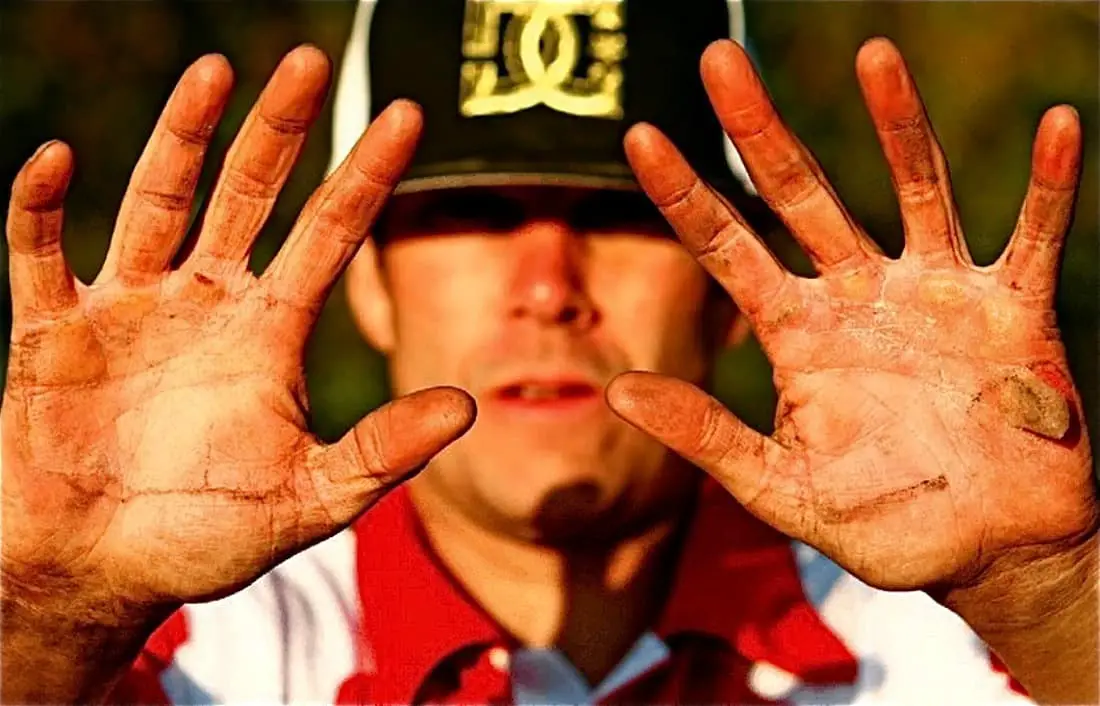TEN THINGS TO KNOW ABOUT AVOIDING BLISTERS
Click on images to enlarge
Blisters. Believe it or not, blisters form to protect the body. When you ride, raised areas of your hand’s palmar surface are susceptible to friction from your gloves and grips. This friction turns into heat. The irritated skin becomes red, and the layers of the skin begin to separate. Your body then gets a signal to protect itself by creating a buffer between your palm and the handlebar. This buffer is filled with fluid that diffuses out of the cells to form what is called a friction blister.
Moisture. When your hands sweat while riding, the moisture contributes to blisters by softening the skin and increasing friction. If you get blisters due to moisture, switch to a pair of minimalistic gloves that are made out of a breathable material.
Gloves. The perfect glove is hard to come by. Why? Everybody’s hands are shaped differently. Some hands have long and narrow fingers, while others are wide and stocky. The typical glove that prevents blisters is one that is form-fitting to the palm without bunching up and has enough ventilation to keep your hands dry. Most top Pros ride with the most minimalistic gloves on the market. Strangely, gloves that have extra padding in the palm tend to bunch up and create more friction.
Ride. The best way to keep blisters away is to ride. The more you ride, the thicker the skin on your hand’s hot spots becomes, forming calluses. These calluses will be the buffer between your delicate skin and the grip. Start with shorter rides and build up slowly.
Bars. There are dozens of different bar bends to choose from these days. The question is, which one is right for you? First off, you want the bars to feel comfortable. Second, take into account the way you grip the bars and your riding style. You have to make sure that the bars align with your hands. If you are an aggressive rider who tends to keep his elbows up, bars that have a big sweep will cause hot spots on your hands. Elbows-up riders should choose a straighter bar like the Renthal RC bend. If you tend to sit down a lot and your elbows tend to sag, a bar with a bigger sweep will fit your style best.
Technique. The quickest way to get blisters is to adopt a death grip on the bars. Riders have a tendency to do this when they use their hands rather than their legs to grip the bike. By squeezing the bike with your legs and using your torso to stabilize your fore and aft movement, you can relax your grip on the bars and let the bike work underneath you.
Tape. There are many different techniques for taping hands to lower the risk of blisters. But, for many riders, tape is not a good idea. Hands that sweat more than normal create moisture that peels up the tape, which gets bunched up in the gloves, making matters worse. There are adhesive sprays that you can use before placing the tape on for better stiction. There is a small company that makes that makes special hand and thumb tape that is elastic and form fits to your hand and thumb. You can reach them at www.holditwide.com.
Double up. What about wearing gloves under your gloves? There are riders who swear by PC Racing’s Underware gloves. They are made out of Kevlar fibers that fit the hand snugly to buffer the friction from your glove or grip. The downside of doubling up is the added thickness. As with anything, there is some give and take, but for many riders the juice is worth the squeeze.
Too big. Maybe you already have the manly, callused hands of a serious rider but still have issues with blisters. Chances are you’re just not taking proper care of your calluses. Calluses can get too big. When this happens, the edge of the callus forms a hot spot that creates a new blister next to the old callus. This can lead to the callus being ripped off. Not good. Use a pumice stone or callus shaver to remove excess layers of dead skin to minimize hot spots. Moisturizing rough hands at night will minimize cracking and potential hot spots.
Neoprene. Products like Palm Savers and Palm Protectors are a cheap and simple way to protect your hands. Neoprene material is wrapped around your hand and acts as a buffer between your hand and the grip. The material is fairly thin but still noticeable while riding.







Comments are closed.